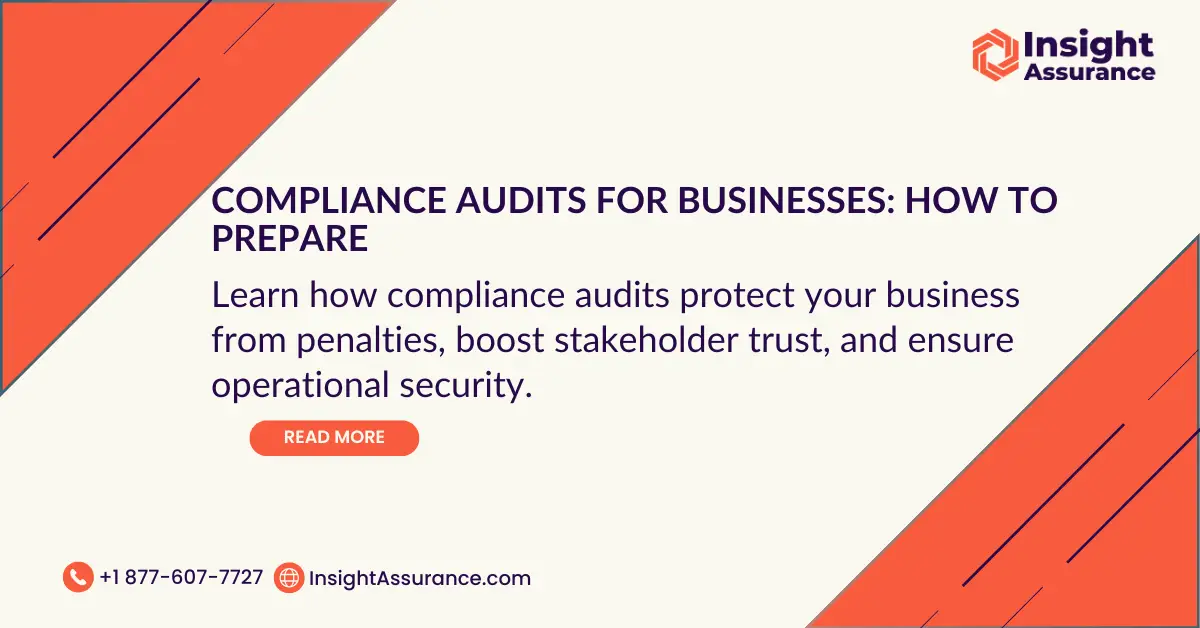Regulations are constantly evolving, and staying compliant is essential for protecting your business and maintaining trust. Compliance audits help your organization meet industry standards, mitigate risks, and operate with confidence.
A well-prepared audit can uncover gaps, strengthen internal controls, and prevent costly penalties. This guide breaks down the process step by step, making compliance audits more manageable and less overwhelming.
Understanding the Compliance Audit Process
A compliance audit is a structured review that assesses if your business meets regulatory requirements, industry standards, and internal policies. It helps identify potential risks, strengthen ethical practices, and confirm that your operations align with compliance expectations. Beyond avoiding fines or legal trouble, a well-executed audit builds trust with customers, partners, and stakeholders — demonstrating your commitment to accountability and security.
The compliance audit process typically involves four key stages:
- Planning and Preparation: Define the audit’s scope, objectives, and requirements. This involves gathering documentation, understanding regulatory obligations, and outlining the review process.
- Execution: Auditors assess policies, review records, and interview key personnel to evaluate compliance effectiveness. They test controls to determine if they meet industry and regulatory standards.
- Reporting: Findings are compiled into a report detailing areas of compliance and non-compliance, along with recommendations for improvement.
- Follow-Up: Businesses implement corrective actions, monitor compliance efforts, and prepare for future audits to maintain ongoing adherence.
Knowing what to expect can help reduce stress and ensure a smoother audit experience. With the right preparation, businesses can streamline the process, strengthen internal controls, and stay ahead of compliance risks.
Step-by-Step Guide To Preparing for a Compliance Audit
Preparing for a compliance audit doesn’t have to be overwhelming. Follow these key steps to stay organized, minimize risk, and ensure a smooth process:
Step 1: Understand Regulatory Requirements
Researching and comprehending the relevant laws, regulations, and industry standards is the foundation of effective compliance. It’s essential to:
- Identify Applicable Regulations: Determine which regulatory compliance requirements apply to your organization based on your industry, location, and operations. This may include data protection laws like the General Data Protection Regulation (GDPR), financial reporting standards, or healthcare compliance audit requirements such as HIPAA compliance.
- Stay Informed on Updates: Regulations evolve over time. Keep abreast of any changes that could impact your compliance obligations by subscribing to industry publications or consulting regulatory compliance experts.
- Assess Internal Policies: Ensure that your internal compliance policies and procedures align with external regulatory requirements and industry standards.
Step 2: Organize Documentation
Thorough documentation is a critical aspect of the compliance audit process. Gathering and organizing necessary documents in advance facilitates a more efficient audit.
Common documents include:
- Policies and Procedures: Documentation of internal policies, compliance standards, and procedures that govern your operations.
- Financial Records: Financial statements, accounting services records, and audit findings that demonstrate financial compliance audit readiness.
- Operational Manuals: Guides and manuals that outline operational processes relevant to regulatory compliance.
- Training Records: Evidence of compliance training sessions attended by employees, showcasing your commitment to ethical practices.
- Previous Audit Reports: Reports from past internal audits or external audits, including any compliance audit checklists used.
By categorizing these documents and ensuring they’re easily accessible, you enhance transparency and reduce delays during the audit.
Step 3: Conduct Internal Audits
Performing internal pre-audits allows you to identify and address compliance issues before the official audit by:
- Utilizing Internal Teams or External Experts: Assemble a team of internal auditors or hire certified internal auditors to conduct a mock audit. Their expertise can uncover operational audit deficiencies and compliance risks.
- Assessing Internal Controls: Evaluate the effectiveness of your internal controls and compliance frameworks against regulatory compliance audit standards.
- Implementing Corrective Actions: Address any compliance gaps discovered during the internal audit to ensure readiness for the external audit.
Step 4: Train Employees
Compliance is a company-wide effort, and employees need to understand their role. That’s why it’s important to:
- Educate Staff on Compliance Policies: Provide training sessions that explain regulatory requirements, compliance efforts, and each employee’s responsibilities.
- Foster a Culture of Compliance: Encourage ethical practices and emphasize the importance of compliance in daily operations.
- Regular Training Sessions: Implement ongoing training programs to keep employees informed about compliance standard updates and best practices.
Well-trained employees contribute to effective compliance audit processes and reduce the likelihood of compliance issues arising.
Step 5: Engage with Auditors
Clear communication with auditors makes the process smoother.
- Keep an Open Dialogue: Engage with compliance auditors early to understand their expectations and clarify the audit scope.
- Provide Access to Information: Ensure auditors have the necessary access to documentation, internal auditors, and relevant operational areas.
- Demonstrate Cooperation: Be transparent and cooperative throughout the audit process to build trust and facilitate a more efficient audit.
Step 6: Address Identified Issues
An audit isn’t just about identifying issues — it’s about fixing them. After the audit, it’s crucial to act on the findings promptly:
- Create an Action Plan: Develop a structured plan to address each compliance issue identified, prioritizing actions based on risk level and regulatory impact.
- Detailed Prioritization: High-Risk Issues: Immediate corrective actions for compliance gaps that pose significant regulatory compliance risks.
- Medium-Risk Issues: Scheduled remediation for issues that could affect operational audit efficiency or compliance efforts.
- Low-Risk Issues: Monitor and plan for improvements that enhance overall compliance but pose minimal immediate risk.
- Implement Changes: Assign responsibilities and timelines to ensure effective compliance audit recommendations are executed.
Step 7: Review and Improve
Last but not least, compliance isn’t a one-time event — it’s an ongoing process. Continuous improvement is key to maintaining compliance over time. This means:
- Regular Reviews: Schedule periodic assessments to evaluate the effectiveness of implemented changes and compliance policies.
- Updating Compliance Programs: Adjust your compliance program to reflect new regulatory requirements or operational changes.
- Monitoring Compliance Efforts: Keep track of compliance efforts to identify trends, successes, and areas needing improvement.
By embedding compliance into the organizational culture, businesses can minimize compliance risks and maintain ongoing adherence to regulatory requirements.
Overcoming Challenges in Compliance Auditing
Businesses often encounter several challenges during compliance audits that can hinder the effectiveness of their compliance programs.
Here are a few common compliance challenges and how to address them:
Challenge 1: Keeping Up with Regulatory Changes
Evolving regulations can create significant difficulties in maintaining compliance. Laws and industry standards are frequently updated to address new risks, technologies, and market conditions. This constant change makes it challenging for organizations to stay current with compliance requirements.
To effectively manage this challenge:
- Subscribe to Industry Updates: Regularly receive updates from regulatory bodies, industry associations, and professional networks to stay informed about changes in compliance standards and regulatory requirements.
- Engage Compliance Experts: Consult regulatory compliance experts or legal advisors who specialize in your industry to gain insights into upcoming changes and how they may impact your operations.
- Attend Training and Seminars: Participate in conferences, workshops, and webinars focused on compliance auditing and regulatory developments to enhance your understanding of new requirements.
Staying informed helps you adapt your business’s compliance efforts to meet new regulations and avoid compliance gaps.
Challenge 2: Resource Constraints
Limited resources can also hinder audit preparation and execution, especially for startups and small to medium-sized organizations. Constraints in personnel, time, or budget can impact the ability to conduct thorough internal audits and implement effective compliance programs.
To address resource limitations:
- Prioritize High-Risk Areas: Focus on areas with the highest compliance risks and regulatory impact. Allocating resources strategically ensures that critical compliance issues are addressed first.
- Leverage External Support: Consider engaging external auditors or compliance auditing firms to supplement internal efforts. Outsourcing can provide access to certified public accountants and compliance auditors with specialized expertise.
- Streamline Processes: Implement efficient compliance audit processes and utilize technology to automate routine tasks, reducing the burden on internal staff.
By optimizing resource allocation and seeking external assistance, organizations can enhance their compliance auditing without overextending their capabilities.
Challenge 3: Employee Resistance
Resistance to change among employees can impact compliance efforts significantly. Staff may be reluctant to adopt new compliance policies or participate fully in the compliance audit process.
To overcome employee resistance:
- Foster a Culture of Compliance: Promote the importance of ethical practices and regulatory compliance throughout the organization. Emphasize how compliance supports business success and protects stakeholders.
- Effective Communication: Clearly communicate compliance requirements and the role each employee plays in maintaining compliance. Provide regular updates and encourage open dialogue about concerns.
- Training and Education: Offer training sessions to educate employees on compliance policies, internal audit processes, and the benefits of compliance audits for businesses.
Challenge 4: Data Management Issues
Poor data management can lead to compliance breaches, especially with regulations like the GDPR and industry standards concerning data security. Inadequate data handling practices can also result in compliance issues during audits.
To mitigate these data management challenges:
- Implement Robust Data Systems: Invest in secure data management systems that ensure data integrity, confidentiality, and availability. This includes cybersecurity measures to protect against unauthorized access.
- Data Governance Policies: Establish clear policies and procedures for data handling, storage, and disposal in line with regulatory requirements.
- Regular Audits and Assessments: Conduct periodic internal audits of data management practices to identify and address potential compliance risks.
Challenge 5: Disorganized Documentation
Without proper records, demonstrating compliance with regulatory requirements becomes challenging.
Here are a few best practices for maintaining accurate and accessible records:
- Create a Centralized Documentation System: Establish a centralized system for storing all compliance-related documents, such as policies, procedures, audit reports, and training records.
- Update Documentation Regularly: Keep all documents current by regularly reviewing and updating them to reflect changes in regulations or internal processes.
- Assign Responsibility: Designate specific individuals or teams responsible for maintaining documentation to ensure accountability.
- Keep a Record for Audit Trails: Maintain detailed records of compliance efforts, including evidence of compliance activities and decisions made.
- Ensure Accessibility: Documentation should be easily accessible to those who need it, including external auditors during the compliance audit process.
By adhering to these practices, businesses can improve transparency and demonstrate effective compliance management during audits.
Turning Compliance Into a Competitive Advantage
Compliance isn’t just about checking boxes — it’s about protecting your business, building trust, and staying competitive. Regular audits help uncover risks, streamline operations, and keep you aligned with evolving regulations.
At Insight Assurance, we make compliance audits clear, efficient, and stress-free. Our team of experts provides independent, objective assessments that simplify the process — so you can focus on what matters most.
Let’s make compliance work for you. Get in touch today.


